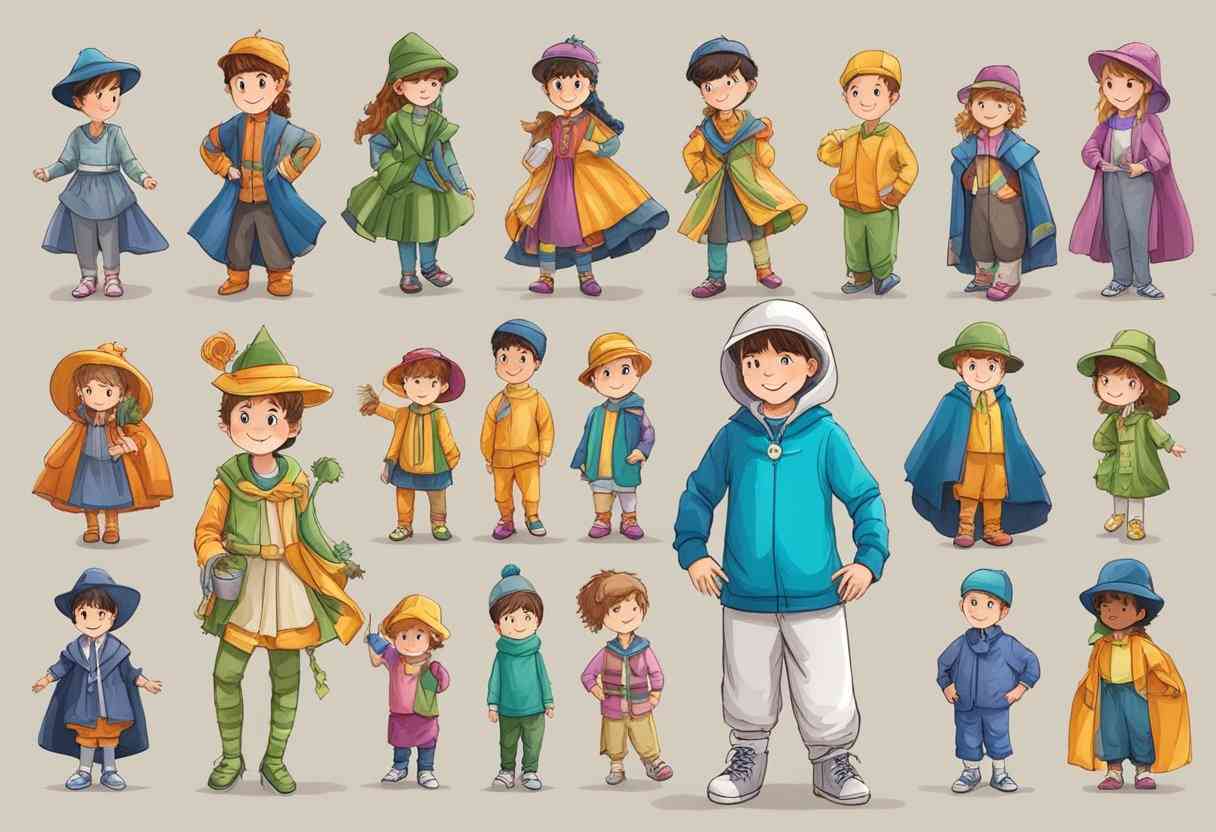Children with autism may face challenges when it comes to participating in Halloween festivities. Sensory issues, difficulty with social interactions, and other factors can make it challenging for them to enjoy the holiday. However, with some careful planning and consideration, parents and caregivers can help make the experience more enjoyable for their child.
One aspect to consider is the child’s sensory needs. Many children with autism are sensitive to certain textures, sounds, and smells. This can make it difficult to find a costume that is comfortable and not overwhelming. Parents and caregivers can look for costumes made from soft, breathable materials and avoid those with scratchy tags or other irritating features.
Another consideration is the social aspect of Halloween. Children with autism may struggle with social interactions and may feel uncomfortable or overwhelmed in crowds. Parents and caregivers can help by choosing costumes that allow the child to feel more comfortable and confident.
This might mean avoiding costumes that are too bulky or restrictive or choosing a costume that reflects the child’s interests and personality. With some careful planning and consideration, parents and caregivers can help make Halloween a fun experience for children with autism.
Autism and Costume Selection
When selecting a costume for a child with autism, it is important to understand their unique needs and preferences. Autism is a neurodevelopmental disorder that affects communication, social interaction, and behavior. Children with autism may have sensory sensitivities, special interests, and other preferences that can impact their costume choices.
Sensory-Friendly Costumes
Many children with autism have sensory sensitivities, which can make it difficult for them to tolerate certain textures, fabrics, or clothing items. Sensory-friendly costumes are designed to minimize sensory input and provide a comfortable, non-restrictive fit. These costumes may feature soft, lightweight materials, flat seams, and adjustable closures.
Special Interests
Children with autism often have special interests or obsessions that they are passionate about. Incorporating their special interests into their costume can make the experience more enjoyable and meaningful. For example, a child who loves trains may enjoy dressing up as a conductor or engineer.
Visual and Auditory Sensitivities
Children with autism may have visual and auditory sensitivities, which can make certain costumes overwhelming or uncomfortable. Bright colors, flashing lights, and loud noises should be avoided. Instead, opt for costumes with muted colors and simple designs.
Texture Preferences
Texture preferences can vary widely among children with autism. Some may prefer soft, plush fabrics, while others may prefer smooth or slick materials. It is important to select a costume that matches their individual texture preferences.
Adaptive Costumes
Adaptive costumes are designed to accommodate children with physical disabilities or other special needs. These costumes may feature Velcro closures, elastic waistbands, or other adjustable features that make them easier to put on and take off.
Gender-Neutral Options
Many children with autism may not conform to traditional gender roles or expectations. Gender-neutral costume options can provide a more inclusive and accepting environment for these children.
Weight and Sensory Input
Some children with autism may benefit from costumes that provide additional weight or sensory input. Weighted vests, compression clothing, or other sensory-friendly accessories can help regulate sensory input and provide a calming effect.
Selecting a costume for a child with autism requires careful consideration of their unique needs and preferences. By taking these factors into account, parents and caregivers can help to ensure a positive and enjoyable costume experience for their child.
Inclusive Costume Ideas
When it comes to choosing a costume for kids with autism, it’s important to keep in mind that inclusivity and peer interaction should be a top priority. Here are some inclusive costume ideas that can help make your child’s Halloween experience more enjoyable:
Gender-Neutral Options
Gender-neutral costumes are a great way to ensure that all kids feel included and comfortable. Some popular gender-neutral options include animals, superheroes, and food items. These costumes are not only fun and creative, but they also promote a sense of equality and acceptance.
Adaptive Costumes
Adaptive costumes are designed to be more comfortable and accessible for children with disabilities. These costumes often feature sensory-friendly materials and adjustable closures. Some popular adaptive costumes include princesses, superheroes, and animals.
Inclusivity and Peer Interaction
When choosing a costume, it’s important to consider how it will impact your child’s ability to interact with their peers. Costumes that are too complex or difficult to move around in can make it harder for kids to socialize and participate in activities. Simple costumes, such as animals or characters from popular movies or TV shows, can help kids feel more comfortable and confident.
When selecting a costume for a child with autism, it’s important to prioritize inclusivity, gender neutrality, and adaptability. By choosing a costume that is both fun and comfortable, you can help ensure that your child has a positive Halloween experience.
Choosing Comfortable and Safe Accessories
When it comes to selecting accessories for kids with autism, it is crucial to prioritize comfort and safety. Here are some tips to keep in mind while choosing accessories for your child:
Comfortable Footwear
Comfortable footwear is essential for kids with autism, especially if they have sensory processing issues. It is best to avoid shoes that are too tight or too loose, as they can cause discomfort and irritability. Instead, choose footwear that fits well and provides adequate support. Sneakers or shoes with soft soles and adjustable straps are good options.
Safe Accessories
Safety is another critical factor to consider while selecting accessories for kids with autism. Avoid accessories that have sharp edges or small parts that can be swallowed. Also, make sure that the accessories are non-toxic and do not contain any harmful chemicals. It is always best to opt for accessories that are specifically designed for kids with autism.
Sensory-Friendly Makeup
If your child loves makeup, it is essential to choose sensory-friendly options. Avoid makeup products that have strong fragrances or contain harsh chemicals. Instead, opt for products that are hypoallergenic, fragrance-free, and gentle on the skin. It is also a good idea to choose makeup products that are easy to apply and remove.
Overall, choosing comfortable and safe accessories is crucial for kids with autism. By keeping these tips in mind, parents can ensure that their child is comfortable and safe while expressing themselves through accessories.
Importance of Sensory Breaks
Children with autism often have sensory processing difficulties that can make it challenging for them to participate in Halloween activities. Sensory breaks can be a helpful tool for children with autism to regulate their sensory input and manage their emotions.
Sensory breaks are a short period when the child can take a break from the sensory input around them. This can include noise, light, touch, and smell. Sensory breaks can be especially helpful during Halloween when there are a lot of sensory stimuli, such as loud music, flashing lights, and strong smells.
Sensory breaks can take many forms, such as taking a walk outside, engaging in a calming activity like coloring or playing with sensory toys, or simply finding a quiet space to relax. It is important to note that sensory breaks should not be used as a punishment or a way to isolate the child. Instead, they should be seen as a proactive measure to help the child regulate their sensory input and manage their emotions.
By incorporating sensory breaks into Halloween activities, children with autism can feel more comfortable and less overwhelmed. This can help them enjoy the holiday and participate in activities that they may have otherwise found too challenging.
Communication Tools in Costumes
Children with autism often face challenges with communication, which can make it difficult for them to express themselves while wearing a costume. However, several communication tools can be incorporated into costumes to help children with autism feel more comfortable and confident.
One simple communication tool is a laminated card that can be attached to the costume. The card can include the child’s name, age, and any important information that others should know about the child, such as any sensory issues or communication preferences. This can be especially helpful for children who may not be able to communicate their needs effectively.
Another helpful communication tool is a visual schedule. A visual schedule can be created using pictures or symbols to help the child understand what will happen during the event or activity. This can help reduce anxiety and provide a sense of structure and predictability for the child.
In addition to communication tools, it is important to consider the sensory needs of the child when choosing a costume. Some children with autism may have sensory sensitivities, and certain fabrics or textures may be uncomfortable or overwhelming for them. It is important to choose a costume that is comfortable and does not cause any discomfort or distress.
Incorporating communication tools into costumes can help children with autism feel more comfortable and confident while participating in Halloween or other events. By understanding and accommodating the unique needs of each child, parents and caregivers can help ensure that all children have a positive and enjoyable experience.
Prioritizing Accessibility in Costumes
When selecting costumes for kids with autism, accessibility should be a top priority. This means choosing costumes that are comfortable, safe, and easy to wear.
One important consideration is sensory sensitivity. Many children with autism are hypersensitive to certain textures, materials, and sounds. Costumes that are too tight, scratchy, or noisy can be overwhelming and distressing. Soft, stretchy fabrics like cotton or fleece are often a good choice. It is also important to avoid costumes with masks or hats that cover the face, as these can be uncomfortable or frightening for some children.
Another important consideration is mobility. Some children with autism may have difficulty with fine motor skills or may be sensitive to the weight or bulkiness of certain costumes. Costumes that are easy to put on and take off, and that allow for free movement, are often the best choice. For example, a superhero costume with a simple cape and mask may be more comfortable than a full-body suit with lots of accessories.
Safety is a key concern, Costumes should not pose any physical hazards, such as sharp edges or loose parts that could be swallowed or choked on. It is also important to ensure that costumes are visible in low-light conditions, such as by adding reflective tape or choosing bright colors.
By prioritizing accessibility in costume selection, parents and caregivers can help ensure that children with autism have a safe and enjoyable Halloween experience.











